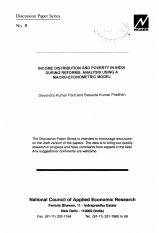Income Distribution and Poverty in India During Reforms: Analysis Using a Macro-Econometric Model
September 1999
Poverty alleviation and economic growth is high on the government's policy agenda since independence. Studying the impact of economic growth on income distribution and poverty assumes further significance in light of the ongoing economic reform process in the country. In this paper, income distribution and incidence of poverty in India are derived for the period 1994-95 to 2000-01 using a macro-econometric model. Unlike other studies, here, an attempt has been made to forecast poverty at 6 rural and 6 urban household group levels. Household income data generated from the “Micro Impact of Macro Adjustment Policies in India” (MIMAP-India) survey is used in this study. Between groups, inequality in rural areas is consistently higher and increasing at a faster rate as compared to urban areas. Though the incidence of poverty will decline both in rural as well as urban areas, decline will be faster in urban areas. However, agriculture dependant households (labour as well as self-employed) and non-agricultural labour households have higher incidence of poverty in the beginning and rate of decline is slower. The remaining household categories have low incidence of poverty. Poverty gap ratio and FGT index of poverty also depict similar trends as observed for the head count ratio.
National Growth and Macroeconomic Centre






